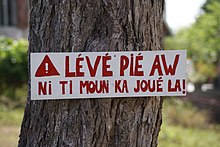
Back Kreools Afrikaans Kreolsprachen ALS لغة مولدة Arabic Llingua criolla AST Kreol dili Azerbaijani Крэольскія мовы Byelorussian Basa peranakan BEW Креолски език Bulgarian Yezhoù kreolek Breton Llengua criolla Catalan

A creole language,[2][3][4] or simply creole, is a stable natural language that develops from the process of different languages simplifying and mixing into a new form (often a pidgin), and then that form expanding and elaborating into a full-fledged language with native speakers, all within a fairly brief period.[5] While the concept is similar to that of a mixed or hybrid language, creoles are often characterized by a tendency to systematize their inherited grammar (e.g., by eliminating irregularities or regularizing the conjugation of otherwise irregular verbs). Like any language, creoles are characterized by a consistent system of grammar, possess large stable vocabularies, and are acquired by children as their native language.[6] These three features distinguish a creole language from a pidgin.[7] Creolistics, or creology, is the study of creole languages and, as such, is a subfield of linguistics. Someone who engages in this study is called a creolist.
The precise number of creole languages is not known, particularly as many are poorly attested or documented. About one hundred creole languages have arisen since 1500. These are predominantly based on European languages such as English and French[8] due to the European Age of Discovery and the Atlantic slave trade that arose at that time.[9] With the improvements in ship-building and navigation, traders had to learn to communicate with people around the world, and the quickest way to do this was to develop a pidgin; in turn, full creole languages developed from these pidgins. In addition to creoles that have European languages as their base, there are, for example, creoles based on Arabic, Chinese, and Malay.
The lexicon of a creole language is largely supplied by the parent languages, particularly that of the most dominant group in the social context of the creole's construction. However, there are often clear phonetic and semantic shifts. On the other hand, the grammar that has evolved often has new or unique features that differ substantially from those of the parent languages.[10]
- ^ "Multilingualism and language contact | Languages In Danger". Retrieved 2020-04-09.
- ^ "The study of pidgin and creole languages" (PDF).
- ^ "Language varieties: Pidgins and creoles" (PDF). Archived from the original (PDF) on 2018-07-12. Retrieved 2017-05-24.
- ^ "Typologizing grammatical complexities, or Why creoles may be paradigmatically simple but syntagmatically average" (PDF).
- ^ Millar, Robert M. (2015). Trask's historical linguistics. Routledge. pp. 305-306.
- ^ Calvet, Louis-Jean. (2006). Toward an Ecology of World Languages. Malden, MA: Polity Press. [173-6]
- ^ McWhorter, J. H. (2005). Defining creole. Oxford University Press.
- ^ "Creole – Language Information & Resources". www.alsintl.com. Archived from the original on June 20, 2017. Retrieved October 9, 2017.
- ^ Linguistics, ed. Anne E. Baker, Kees Hengeveld, p. 436
- ^ Siegel, Jeff (2008). The Emergence of Pidgin and Creole Languages. New York: Oxford Linguistics. pp. 68–69. ISBN 978-0-19-921666-6.